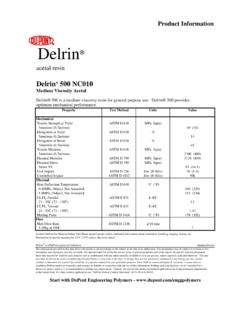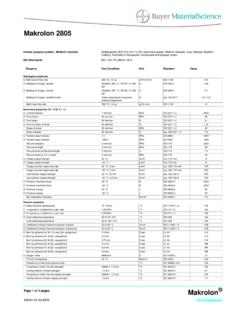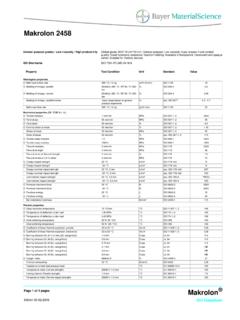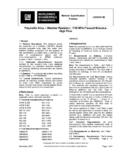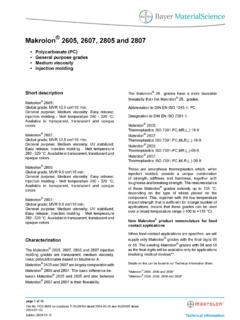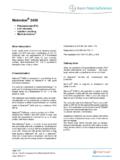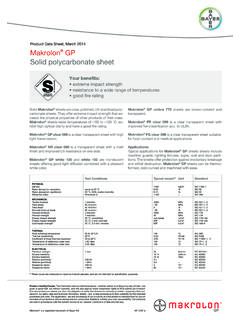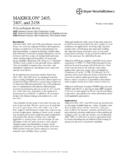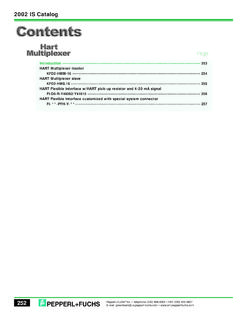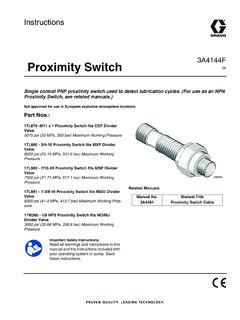Transcription of KU28007 en print - t Link
1 Page 1 of 13 File No.: KU28007 -0501 en Issue 2005-01-05 (replaces TI KU28007 dated 2004-11-11) makrolon Technical information makrolon 3103, 3105, 3107, 3108 and 3158 Polycarbonate (PC) General purpose grades High viscosity Extrusion Injection molding Characterization The makrolon extrusion and injection molding grades are linear, high viscosity polycarbonates on the basis of bisphenol-A. makrolon 3103: UV stabilized makrolon 3105: Easy release makrolon 3107: UV stabilized, easy release makrolon 3108: EU/FDA quality, good hydrolysis resistance makrolon 3158: Easy release, EU/FDA quality, good hydrolysis resistance makrolon 3108 and 3158 are "FDA grades" which fulfill the requirements of the EU countries (includ-ing the BfR recommendations) and the FDA regula-tions for materials in contact with foodstuffs. makrolon 3108 and 3158 are only available in col-ors which, in terms of the coloring agents used, fulfill the FDA regulations for food contact at service temperatures of up to 100 C.
2 Global grade Abbreviation to DIN EN ISO 1043-1: PC Designation to DIN EN ISO 7391-1: makrolon 3103: Thermoplastics ISO 7391-PC,GL,61-09-9 makrolon 3105: Thermoplastics ISO 7391-PC,GR,61-09-9 makrolon 3107: Thermoplastics ISO 7391-PC,GLR,61-09-9 makrolon 3108: Thermoplastics ISO 7391-PC,G,61-09-9 makrolon 3158: Thermoplastics ISO 7391-PC,GR,61-09-9 These are amorphous thermoplastics which, when injection molded, provide a unique combination of strength, rigidity and hardness, together with tough-ness and breaking strength. The heat resistance of these makrolon grades extends up to 135 C, de-pending on the type of stress placed on the compo-nent. On simple components, the heat resistance extends to above 140 C. This, together with the low-temperature impact strength that is sufficient for a large number of applications, means that these grades can be used over a broad temperature range (- 100 to +135 C).
3 Additional information In addition to the makrolon grades, special-purpose makrolon grades are also available for extrusion and coextrusion. Details on this can be found in our Technical information Sheet " makrolon 3103 MAS157, 1243, DP1-1816* and DP1-1852*". Page 2 of 13 File No.: KU28007 -0501 en Issue 2005-01-05 (replaces TI KU28007 dated 2004-11-11) makrolon Technical information Delivery form Granules, packed in 25-kg PE bags, FIBC (flexible intermediate bulk containers - big bags), large car-tons with a PE inliner or in bulk. All batches of makrolon are homogenized after production. The makrolon grades are supplied in all color shades with transparent, translucent or opaque coloring and an excellent depth of color. The production plants for makrolon have been certificated to DIN ISO by the appropriate quality organizations.
4 Applications Construction sector: Solid sheet, corrugated sheet, profiles Lighting engineering: Lamp covers, lamp profiles, lighting strips, globe lamps, glazing Safety: Glazing, machine covers, visors Medical devices**: Intravenous connectors The Safety Data Sheet can be supplied on request. ** See Disclaimer for medical application Properties (see also Table) The key characteristic features of molded parts in the makrolon series of grades are: - outstanding light transmission (transparent grades) - high strength and impact strength - dimensional stability, very low dimensional changes - high heat resistance - excellent electrical and dielectric properties - suitable for food contact and medical de-vices** ( makrolon 3108, 3158) Mechanical properties Molded parts made of the makrolon series of grades rank among the rigid materials on account of their strength and hardness, yet also amongst the elastic materials on account of their toughness.
5 The low level of correlation between mechanical properties and temperature is striking; up to 140 C, stress-free parts remain hard and dimensionally stable. Molded parts made of grades in the series pos-sess a particularly favorable energy absorption capacity under impact-type loads. If parts are to be produced that will be exposed to dynamic loading, we recommend that model tests be conducted be-forehand. Stressing in excess of 20 MPa at 20 C and in ex-cess of 10 MPa at 60 C can lead to surface crack-ing after a period of more than 104 hours. If the parts are employed in media other than air, then the permissible values may differ. Over and above this, allowance must be made for reduction factors as a function of the different influencing parameters ( the molded part geometry, gate design and proc-essing conditions).
6 These reduction factors must be specified for each individual case. Influence of coloring on toughness The majority of transparent colors do not cause any change in properties, or at least no major change. Opaque pigments affect toughness depending on the type and quantity of pigment employed. Page 3 of 13 File No.: KU28007 -0501 en Issue 2005-01-05 (replaces TI KU28007 dated 2004-11-11) makrolon Technical information Thermal properties Components made from the makrolon series of grades are noted for their high heat resistance. At low loading levels ( inherent weight) the parts do not undergo any essential deformation at up to 135 C. At above 146 C (glass transition tempera-ture), makrolon starts to soften and as of approxi-mately 220 C it assumes the molten state. Even higher temperatures are required, however, before it attains a flowability that will permit it to be proc-essed on injection molding machines and extruders.
7 Lengthy periods of heating to temperatures in ex-cess of 320 to 340 C leads to thermal decomposi-tion, with carbon dioxide being split off, and discol-oration. The coefficient of thermal expansion is lower than for many other thermoplastics. If the material is subject to temperatures in excess of some 80 C for long periods of time, then a structural change will occur, as a function of the temperature and duration of the thermal treatment, which is characterized by a slight increase in the tensile and flexural strength and a reduction in the notched impact strength. The maximum permitted service temperature for parts made of makrolon grades depends on the shape of the molded part, the type of loading and the specifications. The temperature indices to IEC 60216-1 and UL 746 B can be regarded as practical reference values for the permitted maximum tem-peratures during long-term service.
8 Where a component is subject to a high tempera-ture and mechanical loading simultaneously, the creep behavior must be taken into account. Further details on this can be found in the CAMPUS data-base. Electrical properties The favorable electric properties of molded parts in makrolon grades are not influenced notably by temperature fluctuations or by ambient humidity. The change in the measured values at higher fre-quencies must be taken into account when Makro-lon is used in the high-frequency sector. A further advantage is that no electrolytic corrosion is caused. Optical properties makrolon parts made from grades in the series have a high refractive index of The virtually colorless, transparent grades possess a light transmission of up to 89 % in the visible range. Ultraviolet light, by contrast, is absorbed and leads to yellowing and a reduction in the impact strength in the course of time.
9 In all cases where UV radia-tion is emitted, and particularly when it is emitted in conjunction with high temperatures, a UV-stabilized grade should be used ( makrolon 3103, 3107). Finished parts, and particularly lamp covers, can be given subsequent UV protective treatment if re-quired. If sheet is to be used outdoors, the application of an UV absorber-rich coating is recommended. Makro-lon UV absorber concentrates are available for coextrusion. Details on this can be found in our Technical information Sheet " makrolon 3103 MAS157, 1243, DP1-1816* and DP1-1852* . Behavior towards moisture and water (hydrolysis resistance) Molded parts in makrolon absorb only to % water at room temperature with 50 % rela-tive humidity. The physical/technological properties remain virtually unaffected. The dimensional changes are similarly insignificant.
10 With immersion in water and rising temperatures, values of only % or so are achieved. Although the EU/FDA grades, in the form of tableware, for example, can be cleaned many thousands of times in hot water, continuous service in water at temperatures in ex-cess of 60 C or so is not to be recommended, since hot water causes gradual chemical degrada-tion coupled with a reduction in impact strength. makrolon parts in grades 3103, 3105 and 3107 are less suited to applications with hot water contact at above 60 C than are parts in makrolon 3108 and 3158. The same also applies to steam sterilization. The impact strength, notched impact strength and tensile strain at break are reduced through lengthy contact with hot water. This effect can also occur with storage in very moist, hot air. The steam per-meability, measured on 100 m thick film, is 15 g/m d.
